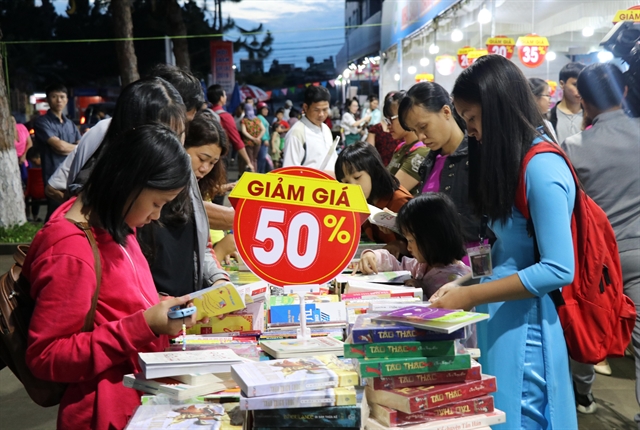 Opinion
Opinion


|
| Students and parents check out children's books at a fair in the Central Highlands Province of Gia Lai in April. Book fairs are seen as the perfect occasion for publishers to introduce their books to a wide audience while readers enjoy the variety of books on display as well as attractive discounts. — VNA/VNS Photo Hồng Điệp |
Khúc Thị Hoa Phương, director and editor-in-chief of Women's Publishing House:
The counterfeit publication issue in Vietnam is out of control, especially the sharing of pirated books on the internet.
Publishing houses that dedicate their efforts to producing the best publications have their works blatantly forged – with counterfeit books either re-typed or scanned and sold online. No small number of consumers are still interested in such books given the cheaper price. Readers accept piracy as the norm since the books are considered a free "public" asset.
This heavily impacts on revenues and profits at publishing houses.
Counterfeit books do not go through careful editing and review processes so they risk carrying incorrect and misleading information.
Those involved in the making or distribution of counterfeit books are only punished with administrative fines that are not enough of a deterrent. These violations should be handled criminally and the businesses responsible should have their licences revoked altogether.
To strengthen the fight against piracy and counterfeit books, law enforcement agencies should be enhanced because they are currently severely understaffed. In addition, the production, sale and storage of counterfeit books should be considered in the same vein as fake goods.
Information security agencies need to thoroughly monitor and investigate offending websites to hand out appropriate sanctions, and the courts need to ramp up their efforts to deliver more appropriate verdicts.
Of course, we also need to raise awareness among the public in the fight against counterfeit and fake books.
Vũ Thị Quỳnh Liên, deputy director of Kim Đồng Publishing House:
Counterfeit books are being produced in an increasingly sophisticated manner, making them harder to spot with the naked eye when put side by side with a genuine copy without using specialised techniques.
The most harmful consequence of counterfeit books is not just they violate intellectual properties rights but the fact they could discourage publishers and writers from investing time and resources into making a quality product.
Many are to blame for the current rampant violations. From the management level, central and local authorities have not been doing enough to monitor and control publishing agencies. The offending publishers make so much profit from fake products that a fine is just a slap on the wrist they are happy to pay and continue their violations.
Readers embrace counterfeit products since they are more affordable and they do not really care about intellectual property rights.
Châu Huy Quang, managing partner of Rajah & Tann LCT Lawyers:
Việt Nam has a fairly comprehensive legal system concerning intellectual property rights but unfortunately, the implementation of these regulations to protect the rights and interests of authors leaves a lot of room for improvements.
There has not been high-profile court cases that could be used as case law in future cases and hold up a warning for any would-be offender.
Nguyễn An Tiêm, deputy chairman of the Việt Nam Publishing Association:
There are three kinds of illegal books that are prevalent in the market.
The first is unauthorised books, ones that are published without any form of approval from the authorities. This is the most “dangerous” because there is no guaranteeing the quality of these products and they could negatively influence the knowledge and mindset of the readers.
The second type is additional copies made by the printing houses – for example, they could print 1,000 books as per the licence or agreement with the publisher, but then they print another 5,000-7,000 exact copies. These additional copies are considered illegal but since the printing houses don’t need to worry about rights’ fees for these copies these illegal copies can be sold at half the price of genuine, IP-protected copies. This practice, aided and abetted by the printing companies and book stores themselves, could undermine the whole industry.
The third type is those with content that bears no relations to what was registered and approved by the licensing authorities.
We currently deal with counterfeit books by issuing administrative fines. If this lenient punishment continues, I’m afraid we will never have a strong, developed publishing industry. — VNS